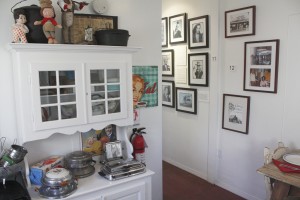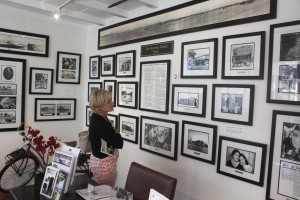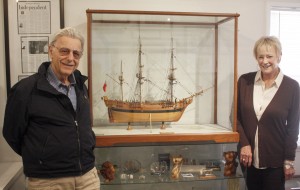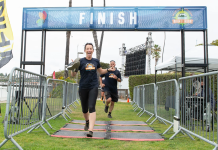
But for museums and libraries, most of life’s historical, scientific, artistic, and cultural stories would be lost.
And if not for the compact Balboa Island Museum & Historical Society, so probably would the colorful, 100-year history of Balboa Island.
The 15-year-old museum is now housed in two classic cottages at 331 Marine Ave., just across the Balboa Island bridge on your starboard side.
The rear cottage, housing the museum, was built in 1947; the front cottage, now a store, was erected in 1926.
Established in 2000 in a small, second floor room near the Balboa Ferry, the original museum was about as inconspicuous as a beached shell; occasional passers-by would see it, but few were curious enough to ascend the narrow staircase to learn about the island.
The museum’s original president, Sharon Lambert, doubtlessly discouraged by the paucity of visitors, reached out to island neighbor Shirley Pepys for assistance in finding a new, more-visible site.
Now a decade and a half later, there’s no doubt that it’s a different museum, thanks to the energy and forward-thinking

creativity of the museum’s board, led by Pepys, as longtime Balboa resident, businesswoman and philanthropist, along with an enthusiastic team of nearly 70 docents and volunteers.
After she sold her national children’s wear design, manufacturing and distribution company, NoJo, Pepys opened a gift store and party place on Marine Ave., called Teddy Bears and Tea Cups, which served as a transition into retirement.
She understands corporate finance, leadership and marketing – skills that even a community museum requires to remain viable and attractive.
Her experience in producing crowd-generating trade show exhibits “translates well to the exhibits in the museum,” she said.
“Newport has a colorful history, and so does Balboa Island,” Pepys said. That’s not just her opinion, for the sign-in book reveals “hundreds and hundreds” of comments from visitors from around the world, including such countries as Portugal, Germany, Japan, Britain, Spain, and Brazil.
Sample comments: “Best little museum we’ve ever been to.” “It’s charming, there’s no place like it that we’ve been to.” “A feel of the 1800s. Love the photos.” “A wonderful feeling – makes us happy.”
A museum is a living entity, which means there must be a nutrient source. That comes in the form of donations – corporate, city, trusts, foundations, and individuals. Nearly 350 names are listed on the donor sheet for 2015, which, along with income from the gift shop, covers the $130,000 annual operating costs.
The museum has but one employee, Assistant Director Jennifer Keil, and her fit couldn’t be more appropriate. She earned her Master’s Degree in Oral and Public History from Cal State Fullerton.
To meet Keil, you’d expect that she also earned her doctorate in Enthusiasm. She came to the museum last year when she and her sister, Cindy, helped to institute the museum’s oral history project, titled “Over the Bridge.” As Balboa Island’s original cottage homes are inexorably disappearing, so are some of the more senior residents. Keil’s and the museum’s timing couldn’t be better.
Museum displays, heavily photographic, trace the island’s development, literally from the “birth” of the island, to first families, to first businesses, to Hollywood connections, to its famous food culture.
The museum offers a fact-packed island biography in its brochure (not a bad source for school history reports).
Also, there are fascinating exhibits ranging from a diorama of the Balboa Ferry, to maritime collectibles that include fancy knot work, marlinspike tools to impossible-to-figure-out-how-they-got-in-there sailing ships in small bottles.
The Museum Store provides unique gifts not found in many of the other retail outlets on Marine Ave., and features historical prints, island artwork, original jewelry, home décor, and of course museum T-shirts.
Inventory, as well as complete museum information, can be previewed online at balboaislandmuseum.org. Store hours are Tuesday through Sunday, 10-4.
You can also purchase tickets online for the Balboa Island Hillbillies event on Saturday, Nov. 21. Celebrate with Balboa Island Museum in the iconic home of Buddy Ebsen (star of TV’s “Beverly Hillbillies”) from 4 to 8 p.m. Dinner and dancing with the Retros is included. Tickets are $50 per person. Hillbilly attire is optional.
Although the island’s appearance is changing, the Balboa Island Museum & Historical Society is open Wednesdays, Fridays, Saturdays and Sundays, 10 a.m. to 4 p.m. to remind residents and visitors alike that the island’s classic and famous lifestyle still exists – and why.

SIDEBAR: HMS Bounty Has New Berth at Museum
The Balboa Island Museum is the new display home of HMS Bounty, an award-winning model made from scratch over a period of nearly five years by Newport Beach physician, Henry Bikhazi.
Bikhazi is nationally known for his incredibly detailed and accurate models, most of which focused on ships from the mid-1700s to mid-1800s.
If it hadn’t been for the storied mutiny made famous by several Hollywood productions, Bounty would have remained a minor player in the history of the British Navy. She started as a merchant vessel purchased by the Navy for a botanical mission in the South Pacific – to acquire breadfruit in the South Pacific for transport to British possessions in the West Indies.
HMS Bounty measured nearly 91-feet in length, with a beam of just over 24-feet. Capt. William Bligh commanded a crew of 44 officers and men; Lt. Fletcher Christian was second in command. Of the 42 crewmen, 22 joined the mutiny. The remainder stayed with Bligh, who safely skippered a small boat across more than 3,500 miles of open ocean, losing but one sailor to hostile natives on the first island on which they tried to land. The mutineers ultimately landed on remote Pitcairn Island.
Contact the writer: [email protected].




